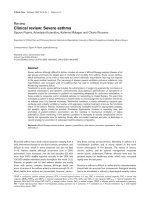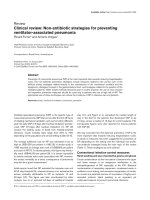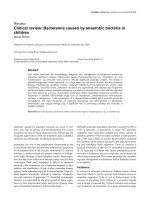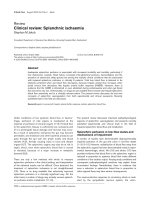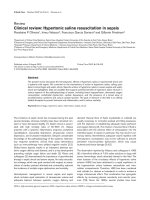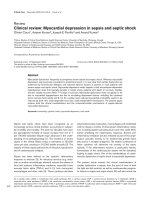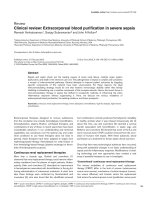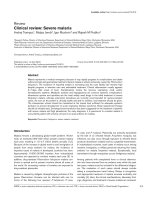Báo cáo y học: "Clinical review: Drotrecogin alfa (activated) as adjunctive therapy for severe sepsis – practical aspects at the bedside and patient identification Pierre-François Laterre and Xavier Wittebole" pdf
Bạn đang xem bản rút gọn của tài liệu. Xem và tải ngay bản đầy đủ của tài liệu tại đây (64.73 KB, 6 trang )
445
APTT = activated partial thromboplastin time; DIC = disseminated intravascular hemorrhage; ICH = intracerebral hemorrhage; PT = prothrombin
time; rhAPC = recombinant human activated protein C.
Available online />Introduction
In the Recombinant human protein C Worldwide Evaluation in
Severe Sepsis (PROWESS) study [1], recombinant human
activated protein C (rhAPC; drotrecogin alfa [activated]) was
shown to reduce 28-day all-cause mortality in patients with
severe sepsis. The observed reduction in the relative risk for
death was 19.4% (an absolute risk reduction of 6.1%), but
this was associated with an increased risk for bleeding
events. The US Food and Drug Administration has approved
drotrecogin alfa (activated) for the treatment of patients with
severe sepsis but, following a post hoc analysis of data from
the PROWESS study, it has restricted the treatment to
patients at a high risk for death (e.g. as determined by Acute
Physiology and Chronic Health Evaluation II score) [2–4]. The
European Agency for the Evaluation of Medicinal Products
also approved the drug for the treatment of adult patients
with severe sepsis with multiple organ failure, when added to
best standard care [5]. This decision was motivated by the
fact that, in the PROWESS study, those patients with two or
more organ dysfunctions who were treated with drotrecogin
alfa (activated) had a 22% reduction in the relative risk for
death (an absolute risk reduction of 7.4%), with a similar risk
for bleeding as compared with the overall study population
[6]. On the other hand, in patients with a single organ failure,
treatment with drotrecogin alfa (activated) was associated
with a 1.7% absolute risk reduction in 28-day all-cause mor-
tality, which did not achieve statistical significance [7]. This
may partly be explained by the limited size of the subgroup,
which did not provide sufficient power to demonstrate a
benefit in 28-day survival. A new randomized, double-blind,
placebo-controlled, multicenter study [ADDRESS; Adminis-
tration of Drotrecogin alfa (activated) in Early stage Severe
Sepsis], which is expected to include more than 11,000
patients, is ongoing and should resolve the issue regarding
the potential benefit of drotrecogin alfa (activated) in severe
sepsis with lower risk for death.
The main purpose of the present article is to review, based on
data from the PROWESS study and open label studies, the
bleeding risks associated with the use of drotrecogin alfa
Review
Clinical review: Drotrecogin alfa (activated) as adjunctive therapy
for severe sepsis – practical aspects at the bedside and patient
identification
Pierre-François Laterre and Xavier Wittebole
Department of Critical Care and Emergency Medicine, St Luc University Hospital, Brussels, Belgium
Correspondence: Pierre-François Laterre,
Published online: 30 June 2003 Critical Care 2003, 7:445-450 (DOI 10.1186/cc2342)
This article is online at />© 2003 BioMed Central Ltd (Print ISSN 1364-8535; Online ISSN 1466-609X)
Abstract
Administration of drotrecogin alfa (activated) has been demonstrated to reduce mortality in patients
with severe sepsis who are at high risk for death or who have multiple organ dysfunction. This benefit
was associated with an increased incidence of bleeding events, but the latter were mainly procedure
related. Drug infusion interruptions should be instituted, in accordance with recent recommendations.
Monitoring coagulation parameters may help in identifying patients at higher risk for bleeding but it is
not indicated to adjust drug dosage. Acute renal failure and hemodialysis are not contraindications to
this therapy, and no drug dosage adjustment is indicated. Finally, the type and source of infection, and
its anticipated natural history, may determine whether drotrecogin alfa (activated) is indicated as well
as the timing of its administration.
Keywords drotrecogin alfa (activated), hemorrhage, indication, management, severe sepsis
446
Critical Care December 2003 Vol 7 No 6 Laterre and Wittebole
(activated), together with a discussion of practical manage-
ment and suggested recommendations for procedures during
the infusion period. Finally, we discuss the potential indica-
tions for the drug.
Bleeding events associated with drotrecogin
alfa (activated)
rhAPC is the first in a new class of antithrombotic coagulation
inhibitors for the treatment of severe sepsis. APC has anti-
coagulant activity by limiting thrombin formation and by inhibition
of factors VIIIa and Va, and it promotes fibrinolysis by inhibiting
plasminogen activator inhibitor 1 and thrombin-activatable fib-
rinolysis inhibitor [1,8]. APC has also been demonstrated to
modulate the host response to severe infection [9]. Finally,
based on in vitro data, APC is able to inhibit the induction of
apoptosis proteins and may reduce cell death in sepsis [10].
Because of the anticoagulant properties of APC, patients at
major risk for bleeding were not included in the PROWESS
study, and the excluded population consisted mainly of
patients with a recent history (< 3 months) of stroke, neuro-
surgery, mass lesion of the central nervous system, and head
trauma [1]. Also, patients with severe hepatic disease, gas-
trointestinal bleeding (< 6 weeks) unless corrected by
surgery, and major trauma in which clinicians were not confi-
dent in using heparin therapy were excluded from the study.
As was anticipated, administration of drotrecogin alfa (acti-
vated) was associated with an increased incidence of serious
bleeding events as compared with placebo (3.5% versus
2.0%; P=0.06). These events occurred primarily during the
infusion period (2.4% versus 1.0%; P = 0.02). More impor-
tantly, when analyzing the conditions and circumstances
associated with bleeding events, the major difference
appeared to be related to procedures [11,12]. The incidence
of natural bleeding events that occurred in critically ill patients
(e.g. gastrointestinal bleeding) did not differ between patients
treated with drotrecogin alfa (activated) and the placebo
group. Procedure-related bleeding complications consisted
mainly of intra-abdominal, retroperitoneal, and intrathoracic
bleeds secondary to femoral catheter insertion, suprapubic
bladder catheter placement, nephrostomy tube, thoracocen-
tesis, lung biopsy, and decortication [2,11,12]. Thus, particu-
lar attention is warranted when performing procedures during
the infusion period of drotrecogin alfa (activated).
Finally, concomitant prophylactic heparin use was not associ-
ated with an increased risk for bleeding [1]. However, this
observation needs further confirmation because this therapy
was not randomized, and patients at higher risk for bleeding
or with a lower platelet count are less likely to receive heparin
prophylaxis.
Intracranial hemorrhage
Intracranial hemorrhage (ICH) is a feared complication of any
drug that has anticoagulant properties. There are few pub-
lished data on the natural incidence of ICH in severe sepsis.
Oppenheim-Eden and coworkers [13] reported an incidence
of 0.4% of new episodes of ICH in a general intensive care
unit population. The study was retrospective and did not
include trauma and neurosurgical patients. The main factors
associated with ICH were a platelet count below
100,000/mm
3
, renal and hepatic impairment, and sepsis.
The Kybersept study [14] evaluated the efficacy of anti-
thrombin III in severe sepsis. The exclusion criteria were
similar to those employed in the PROWESS trial, except for
criteria regarding risk for ICH, because in the Kybersept
study patients with a past history of stroke, or cranial or
spinal trauma were excluded if the event had occurred within
the past year. In that study the incidence of ICH in the
placebo group was 0.4%. In the PROWESS study, three
patients had an ICH (one patient receiving the placebo and
two receiving drotrecogin alfa [activated]) [1]. For these
latter patients, clinically evident disseminated intravascular
coagulation (DIC) was present and platelet counts
decreased to below 30,000/mm
3
[11]. The incidence of ICH
was recently reported for a total of 2786 patients treated
with drotrecogin alfa (activated) included in controlled trials,
open-label trials, and compassionate use studies [12]. ICH
occurred in 13 out of 2786 patients (0.5%) during the infu-
sion period and in 32 out of 2786 (1.1%) during the 28-day
study period. It is important to note that meningitis or platelet
counts below 30,000/mm
3
were present in 9 out of
13 patients. At the present time the reported incidence of
ICH with commercial use of drotrecogin alfa (activated) is
0.2% (8/3991) [12].
In order to minimize the incidence of ICH during the infusion
period of drotrecogin alfa (activated), the clinician should
adhere to the exclusion criteria given in Table 1.
Finally, even though not listed in the exclusion criteria, particu-
lar attention should paid to infective endocarditis. Infective
endocarditis is associated with neurologic complications in
up to 25% of the patients, with an embolic event being the
most frequent manifestation [15,16]. Mycotic aneurysms may
develop with secondary ICH or subarachnoid hemorrhage. In
this type of infection, brain imaging should be performed in
patients with neurologic impairment before starting drotreco-
gin alfa (activated) in order to rule out the presence of cere-
bral lesions.
Disseminated intravascular coagulation and
thrombocytopenia
Thrombocytopenia (< 30,000/mm
3
) present at baseline was
an exclusion criterion in the PROWESS trial, but if platelet
count dropped below this threshold during the administration
of drotrecogin alfa (activated) then the decision to stop the
drug infusion was left to clinical judgment. Patients with a
platelet count below 50,000/mm
3
, either at entry or during
the first 5 days of study, exhibited an increased incidence of
447
serious bleeding events as compared with the rest of the
population, and this was observed in both placebo and
drotrecogin alfa (activated) treated patients [11]. Interest-
ingly, there was a suggestion of a reduction in mortality for
those patients with a platelet count below 50,000/mm
3
when
treated with drotrecogin alfa (activated; 53% in the placebo
group versus 32% in the treated group). These data must be
interpreted with caution because of the small sample size (47
for placebo versus 46 for study drug) and the potential imbal-
ance in risks for mortality. In the PROWESS study, DIC and
overt DIC were not prospectively defined. In a second analy-
sis, patients were diagnosed with overt DIC at entry if they
met three of the following criteria [15]: presence of petechiae
or purpura fulminans; platelet count below 80,000/mm
3
or
50% decrease from highest value recorded over the preced-
ing 3 days; prothrombin time (PT) more than 21 seconds;
D-dimer level greater than 8 µg/ml; and protein C activity
below 40%. According to these criteria 221 patients had
overt DIC. Among these 221 patients, the 28-day mortality rate
was 52.4% in the placebo arm versus 30.5% in the treated
arm, with an incidence of serious bleeding events of 3.9%
and 3.4%, respectively.
This apparent important benefit in survival rate among
patients with thrombocytopenia or overt DIC and treated with
drotrecogin alfa (activated) must be weighed against an
increased incidence of natural bleeding events. Because
most treatment associated bleeding deaths occurred in this
group of patients, clinicians should maintain platelet counts
above 30,000/mm
3
during the drotrecogin alfa (activated)
infusion period [12].
Surgery and procedures
In the PROWESS study, 455 patients were classified as sur-
gical because they underwent surgery within the preceding
30 days before enrollment or emergency surgery to control
the source of infection [1]. Placebo bleeding rates were lower
in the surgical group, but treatment emergent bleeding events
rates were similar among surgical and nonoperative groups
(19% versus 18%, respectively) [11]. Drotrecogin alfa (acti-
vated) has a short half-life. Following the completion of an
infusion, the decline in plasma concentration is biphasic and
the t
½
α is 13 min with a t
½
β of 1.6 hours [17]. In practice,
90% of the drug is eliminated from serum after 1.8 hours. The
short half-life of the drug allows rapid control of bleeding
events, if they occur, by stopping the infusion. When surgery
or procedures must be performed during infusion of drotreco-
gin alfa (activated), recommendations for infusion interrup-
tions should be followed in order to minimize the risk for
bleeding (Table 2).
Finally, drotrecogin alfa (activated) may influence naturally
occurring coagulation abnormalities observed in severe
sepsis [18]. Activated partial thromboplastin time (APTT) and
PT are further prolonged by a few seconds by the drug, but
the clinician will not be able to differentiate the influence of
Available online />Table 1
Contraindications and warnings for the use of drotrecogin alfa (activated)
Contraindications Warnings
Active internal bleeding Heparin >15 U/kg per hour
Recent (within 3 months) hemorrhagic stroke International Normalized Ratio > 3
Recent (within 2 months) intracranial or intraspinal surgery or severe Platelet count < 30,000/mm
3
, even if platelet count is increased after
head trauma requiring hospitalization transfusions (USA) (European Agency for the Evaluation of Medicinal
Products: contraindication)
Trauma with increased risk for life-threatening bleeding (e.g. liver, Recent gastrointestinal bleeding (within 6 weeks)
spleen or complicated pelvic fractures)
Patients with epidural catheters Recent administration of thrombolytic therapy (within 3 days)
Patients with intracranial neoplasm or mass lesion, or evidence of Recent administration (< 7 days) of oral anticoagulant or glycoprotein
cerebral herniation IIb/IIIa inhibitors
Recent administration (< 7 days) of aspirin >650 mg/day or other
platelet inhibitors
Recent ischemic stroke (< 3 months)
Intracranial arteriovenous malformation
Known bleeding diathesis
Chronic severe hepatic disease (e.g. Child–Pugh C)
Any other condition in which bleeding constitutes a significant hazard or
would be particularly difficult to manage because of its location
Adapted from US Food and Drug Administration [2,3].
448
drotrecogin alfa (activated) from that of sepsis-induced coag-
ulopathy. For this reason, monitoring these coagulation para-
meters is not indicated and would not allow dose adjustment
of the drug.
Hemofiltration and dialysis
Patients with end-stage renal failure who required chronic
dialysis were excluded from the PROWESS study because
of the need for intensive heparin therapy and limited informa-
tion on the medication half-life in this setting [1]. Patients
enrolled in the study and who developed acute renal failure
underwent hemofiltration or dialysis, when indicated, but
heparin doses above 15,000 U/day were not allowed. In this
group of patients there was no increase in the incidence of
bleeding events [18]. In addition, pharmacokinetic and phar-
macodynamic analyses performed in the PROWESS popula-
tion have demonstrated that the serum concentration and
drug half-life did not differ between patients with renal failure
and the population overall [17]. Based on these data, patients
with end-stage renal failure and chronic dialysis should not be
excluded from this therapy.
Drotrecogin alfa (activated) has a molecular weight of 55 kDa
and is not eliminated by hemofiltration or dialysis. Because
pharmacodynamics and plasma concentrations of the drug
are not significantly different in adult patients with renal
failure, no dose adjustment is indicated in this population
[17]. As a result of the anticoagulant properties of the drug,
dialysis or hemofiltration may be performed without heparin or
other forms of anticoagulation. In patients with severe sepsis
and multiple organ dysfunction, PT and APTT are often mod-
erately increased and platelet count may be reduced, limiting
the dose of heparin required to maintain the extracorporeal
circuit patent. It is suggested that hemofiltration or dialysis be
started without concomitant heparin if the patient’s baseline
APTT is above 40 seconds or if the platelet count is below
100,000/mm
3
. If clotting of the extracorporeal circuit occurs
within the following hours then standard heparin may be
added, but APTT (as determined within the circuit) should not
be more than 70 seconds. After drotrecogin alfa (activated)
infusion has been completed, anticoagulation should be con-
ducted following standard practices.
Selecting patients for drotrecogin alfa
(activated) administration
Despite the US Food and Drug Administration and European
Agency for the Evaluation of Medicinal Products indications
for the drug, either for patients with severe sepsis at high risk
for death or with multiple organ failure, when added to the
best standard care, clinicians still often face difficulties in
Critical Care December 2003 Vol 7 No 6 Laterre and Wittebole
Table 2
Drotrecogin alfa (activated) infusion interruptions during procedures: recommended actions
Procedure Action
Minor procedures
Arterial line insertion (radial or femoral) Hold infusion for 2 hours before procedure and restart immediately after, in the
absence of bleeding
Venous femoral line insertion
Intubation or tracheostomy change (unless urgent)
More invasive procedures
Central line or Swan-Ganz insertion Hold infusion for 2 hours before and restart 2 hours after, in the absence of
(subclavian or jugular) bleeding
Lumbar puncture
Chest tube insertion or thoracocentesis
Paracentesis
Percutaneous drainage
Nephrostomy
Gastroscopy (possible biopsy)
Wound debridment (decubitus ulcer, infected wound,
packing changes in open abdomen, etc.)
Major procedures
Surgery (laparotomy, thoracotomy, major debridment, etc.) Hold infusion for 2 hours and wait for 12 hours before restarting infusion
Epidural catheter For epidural catheter, do not use drotrecogin or wait for 12 hours after
removal before starting drug infusion
Adapted from Taylor and coworkers [19].
449
identifying patients to be treated with drotrecogin alfa (acti-
vated). First, severity scores such as Acute Physiology and
Chronic Health Evaluation II score have been well correlated
with outcome in large groups of patients, but they are of
limited help for individuals and cannot be used to guide
therapy. Second, after infection source control has been
achieved, and failing organs supported, when are the effects
of standard care to be expected? In other words, when
should a patient, with severe sepsis and receiving appropri-
ate care, be evaluated with regard to whether they should
receive drotrecogin alfa (activated) as adjunctive therapy?
The indications for this drug should be guided by the type of
infection and expected associated outcome, and the pres-
ence of comorbidities, which may influence the natural history
of the disease. The indications for drotrecogin alfa (activated)
may be divided into ‘early’ and ‘delayed’ indications, and are
presented in Fig. 1.
Early indications
The source of infection has been controlled and optimal stan-
dard care (including adequate antimicrobials and failing organ
support) has been initiated, but the expected effects of this
strategy are either delayed (>12–24 hours) or unpredictable.
These situations include purpura fulminans, toxic shock syn-
drome, and meningitis with multiple organ failure. These
patients could benefit from infusion of drotrecogin alfa (acti-
vated) within 3–6 hours after standard care has been initi-
ated. Clinical evaluation and severity scores, determined at
admission, are not able to predict individual outcome in these
situations, and delaying the initiation of this adjunctive therapy
may lead to irreversible tissue and organ damage. Other
patients who are eligible for early treatment with this drug
may include a subgroup of patients with severe community-
acquired pneumonia admitted to the intensive care unit (i.e.
Streptococcus pneumoniae). Community-acquired pneumo-
nia with multiple organ failure, including hypotension, oliguria,
and metabolic acidosis, are associated with an expected
28-day all-cause mortality in excess of 30%. If the clinical
condition is not improving, or it is worsening, within
6–12 hours after adequate care has been provided, then the
use of drotrecogin alfa (activated) could be considered.
Delayed indications or ‘resuscitate and reassess’
In various conditions, the infection source control and failing
organ support is expected to be associated with a clinical
improvement within 6–12 hours. Despite the initial clinical
severity and the presence of multiple organ failure, surgery or
drainage of the infectious focus is rapidly followed by control
of or improvement in organ dysfunction. These situations
include ascending cholangitis or pyelonephritis, secondary to
obstruction, catheter-related sepsis, and intra-abdominal col-
lections or abscesses drained surgically or percutaneously. If
adequate infection source control has been achieved, and
organ dysfunction is sustained or worsening in the following
6–12 hours, then drotrecogin alfa (activated) may be indi-
cated as adjunctive therapy for severe sepsis. In patients in
whom surgery is required to control infection, a 12-hour delay
must be permitted before drug infusion is initiated. This
period should be used to re-evaluate the adequacy of the sur-
gical procedure and standard care before considering
drotrecogin alfa (activated). This delay should also ensure
Available online />Figure 1
Type of infection and proposed delay between infection source control and drotrecogin alfa (activated) administration. CAP, community-acquired
pneumonia; H, hour; OD, organ dysfunction; UTI, urinary tract infection.
Severe Sepsis
diagnosed
Infection source
control and
OD support
Purpura Fulminans
Toxic Shock S.
Meningitis with
multiple OD
CAP
(severe)
Ascending
cholangitis
Pyelonophritis
with obstruction
Catheter-related
sepsis …
CAP
Peritonitis
Other Surgical
Site Infections
Nosocomial
p
neumonia
UTI …
H 0 H 3 H 6 H 12
450
that adequate hemostasis has been achieved and should
reduce the risk for bleeding during infusion of the drug.
In patients developing nosocomial pneumonia, the indica-
tion for the drug should be evaluated within 12 hours after
adequate standard care has been initiated. In trauma
patients developing nosocomial infections and sepsis-
induced organ dysfunction, particular attention must be paid
to bleeding risks. If the trauma involved solid organs or
pelvis, or if flail chest is present, then the delay between the
initial trauma and the development of sepsis must be taken
into account before considering the use of drotrecogin alfa
(activated). If no bleeding event has occurred during the
week following trauma, then the drug may be administered if
no other contraindication is present. In situations in which
severe sepsis develops during the first few days after
trauma, administration of the drug may be hazardous and
should not be recommended if solid organs (i.e. liver,
spleen) have been fractured or if the trauma was associated
with retroperitoneal bleeding.
‘Too late’ indications
Because of the apparent increased benefit of the drug in
patients at higher risk for death or with more than two organ
failures, some clinicians may be tempted to postpone the
consideration of drotrecogin alfa (activated) as adjunctive
therapy for severe sepsis. In the PROWESS study, the time
window between the development of the first organ dysfunc-
tion and the start of the infusion could reach 36 hours, with a
mean of 17.5 hours. This implies that the benefit of the drug
after this delay has not been evaluated. Prolonging the
waiting period between initiating adequate standard care and
evaluating whether the drug is indicated is not recommended.
Tissue damage and organ dysfunction may be irreversible,
and drotrecogin alfa (activated) should not be used as a
rescue therapy for severe sepsis when all other strategies
have failed to improve the patient’s condition.
Conclusion
Drotrecogin alfa (activated) is the first recognized adjunctive
therapy to improve survival in patients with severe sepsis at
high risk for death, when added to the best standard care.
Because of its anticoagulant properties, the use of this drug
is associated with an increased incidence of bleeding events.
This reinforces the need to select patients adequately, to
weigh risks and benefits of the therapy, and to follow the rec-
ommendations when procedures must be performed, in order
to minimize the incidence of bleeding complications. The use
of the drug should be evaluated when adequate infection
source control has been achieved and appropriate supportive
care has failed to improve the patient’s condition significantly,
after a period of time determined by the type of infection and
associated comorbidities.
Competing interests
P-FL is a consultant for Eli Lilly and Company.
References
1. Bernard GR, Vincent JL, Laterre PF, LaRosa SP, Dhainaut JF,
Lopez-Rodriguez A, Steingrub JS, Garber GE, Helterbrand JD, Ely
EW, Fisher CJ Jr: Efficacy and safety of recombinant human
activated protein C for severe sepsis. N Engl J Med 2001, 344:
699-709.
2. US Food and Drug Administration: Drotrecogin alfa (activated),
Xigris, BLA #125029/0. FDA Briefing Information. US Food and
Drug Administration; 6 August 2001. [ />label/droteli112101LB.pdf].
3. US Food and Drug Administration: Drotrecogin alfa (activated),
Xigris, BLA #125029/0. FDA Briefing Information. US Food
and Drug Administration. [ />droteli112101r1.pdf].
4. Knaus WA, Draper EA, Wagner DP, Zimmerman JE: APACHE II:
a severity of disease classification system. Crit Care Med
1985, 13:818-829.
5. European Agency for the Evaluation of Medicinal Products
(EMEA): European Public Assessment Report [EPAR] Xigris.
European Agency for the Evaluation of Medicinal Products; 17
Oct 2002. [ />xigris/xigris.htm].
6. Dhainaut JF, Laterre PF, Janes JM, Bernard GR, Artigas A, Bakker
J. Riess H, Basson BR, Charpentier J, Utterback BG, Vincent JL:
Drotrecogin alfa (activated) in the treatment of severe sepsis
patients with multiple-organ dysfunction: data from the
PROWESS trial. Intens Care Med 2003, 29:894-903.
7. Ely EW, Laterre PF, Angus DC, Helterbrand JD, Levy H, Dhainaut
JF, Vincent JL, Macias WL, Bernard GR: Drotrecogin alfa (acti-
vated) administration across clinically important subgroups of
patients with severe sepsis. Crit Care Med 2003, 31:12-19.
8. Esmon CT: The protein C anticoagulation pathway. Arterioscler
Thromb 1992, 12:135-145.
9. Riewald M, Petrovan RJ, Donner A, Mueller BM, Ruf W: Activa-
tion of endothelial cell protease activated receptor 1 by the
protein C pathway. Science 2002, 296:1880-1882.
10. Joyce DE, Gelbert L, Ciaccia A, DeHoff B, Grinnell BW: Gene
expression profile of antithrombotic protein C defines new
mechanisms modulating inflammation and apoptosis. J Biol
Chem 2001, 276:11199-11203.
11. Schein RMH, Kinasewitz GT: Risk-benefit analysis for drotreco-
gin alfa (activated). Am J Surg 2002, 184(suppl):25S-38S.
12. Bernard G, Macias WL, Joyce DE, Williams MD, Bailey J, Vincent
JL: Safety assessment of drotrecogin alfa (activated) in the
treatment of adult patients with severe sepsis. Crit Care 2003,
7:155-163.
13. Oppenheim-Eden A, Glantz L, Eidelman LA, Sprung CL: Sponta-
neous intracerebral hemorrhage in critically ill patients: inci-
dence over six years and associated factors. Intens Care Med
1999, 25:63-67.
14. Warren BL, Eid A, Singer P, Pillay SS, Carl P, Novak I, Chalupa P,
Atherstone A, Penzes I, Kubler A, Knaub S, Keinecke HO, Hein-
richs H, Schindel F, Juers M, Bone RC, Opal SM: Caring for the
critically ill patient: high-dose antithrombin III in severe
sepsis:a randomized controlled trial. JAMA 2001, 286:1869-
1878.
15. Heiro M, Nikoskelainen J, Engblom E, Kotilainen E, Marttila R, Koti-
lainen P: Neurologic manifestations of infective endocarditis: a
17-year experience in a teaching hospital in Finland. Arch
Intern Med 2000, 160:2781-2787.
16. Cabell CH, Pond KK, Peterson GE, Durack DT, Corey GR, Ander-
son DJ, Ryan T, Lukes AS, Sexton DJ: The risk of stroke and
death in patients with aortic and mitral valve endocarditis. Am
Heart J 2001, 142:75-80.
17. Macias WL, Dhainaut JF, Yan SC, Helterbrand JD, Seger M,
Johnson G 3rd, Small DS: Pharmacokinetic-pharmacodynamic
analysis of drotrecogin alfa (activated) in patients with severe
sepsis. Clin Pharmacol Ther 2002, 72:391-402.
18. Laterre PF, Heiselman D: Management of patients with severe
sepsis, treated by drotrecogin alfa (activated). Am J Surg
2002, 184(suppl):39S-46S.
19. Taylor FB Jr, Toh CH, Hoots WK, Wada H, Levi M: Towards defi-
nition, clinical and laboratory criteria, and scoring system for
disseminated intravascular coagulation. Thromb Haemost
2001, 86:1327-1330.
Critical Care December 2003 Vol 7 No 6 Laterre and Wittebole
